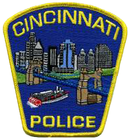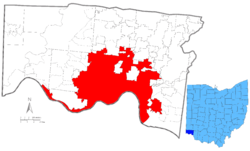- Cincinnati Police Department
-
City of Cincinnati Police Department
Cincinnati Police DepartmentCommon name Cincinnati Police Department Abbreviation CPD Patch of the City of Cincinnati Police Department. Agency overview Formed 1858 Employees 1049 Uniformed & 240 Civilian Volunteers 600 Legal personality Governmental: Government agency Jurisdictional structure Operations jurisdiction* City of Cincinnati in the state of Ohio, USA Map of City of Cincinnati Police Department's jurisdiction. Size 79.6 square miles (206 km2) Population 332,458[1] General nature Operational structure Headquarters Cincinnati, Ohio 45214 Agency executive James E. Craig, Police Chief, Chief of Police Parent agency City of Cincinnati Bureaus 5- Administration
- Patrol
- Resource
- Information Management
- Investigations
Facilities Crown Victorias Sea Ark Website Cincinnati Police Department Footnotes * Divisional agency: Division of the country, over which the agency has usual operational jurisdiction.
Note: Emergency Number: 911 / Non-Emergency Number:(513)765-1212The Cincinnati Police Department is the primary law enforcement agency of Cincinnati, Ohio, USA. The department has 1,057 sworn officers and 281 non-sworn employees. The previous Chief, Col. Thomas H. Streicher retired on March 18, 2011. James E. Craig was appointed Police Chief on August 2, 2011.[2]
Contents
Organization
Under the command of the Police Chief, the Police Department's responsibilities are divided among five bureaus: Patrol, Resource, Investigations, Administration, and Information Management.
Administration
Commanded by an assistant chief, is responsible for coordinating and performing inter-bureau planning tasks, and special research evaluation studies. This bureau consists of the Internal Investigations Section, Planning Section, and Training Section.
Information Management
Is responsible for data collection and retrieval, upgrading/maintenance of technology and information systems, World Wide Web page construction and management, and crime analysis and mapping. This bureau consists of the Police Communications Section, Telephone Crime Reporting Unit, Information Technology Management Section (ITMS), CAD/RMS Project Unit, Crime Analysis Unit, and Records Section.
Investigations
Consists of the Central Vice Control Section and the Criminal Investigation Section. This bureau handles investigations and gathers intelligence involving vice activity, homicides, sex crimes, crimes against children and property crimes.
Patrol
Performs all primary police functions. Bureau personnel respond to citizen requests for police assistance, enforce criminal and traffic laws, investigate criminal activity, take offense reports and regulate non-criminal conduct. It consists of the five police districts, a Night Chief, Patrol Administration, Community Oriented Policing, Vortex Unit, Special Services Section and SWAT.
Resource
Performs a variety of functions that support the operation of the Department. It oversees the operation of the Evidence/Property Management Section, Finance Management Section, Inspections Section, and Personnel Section. It is responsible for the Court Property Unit, Impound Unit, Supply Unit, Fleet Management Unit, Grant/Alarm Unit, Payroll/Purchasing Unit, Court Control Unit, Detail Coordination Unit, Accreditation Unit, Employee Relations Unit, Recruiting Unit, and Background Investigation Unit.
Rank structure and insignia
The Cincinnati Police Department uses these sworn personnel ranks:
Title Insignia Duties Police Chief Chief of Department Assistant Chief/Lt. Colonel Assistant Chief, Commander of Departmental Bureaus Captain Commander of Patrol Districts and Major Units Lieutenant Commander of Specialty Units, District Patrol Shifts, and District Investigative Units Sergeant Squad Commander. Manage relief officers and specialized units Police Specialist Police Officer History
When Cincinnati incorporated as a village in 1802, a ‘night watch’ was established, primarily to guard against fire, but also to ensure the peace. The organization of a police force similar to those in other cities came in 1859 with the appointment of the first police commissioner.[3]
Cincinnati also has a museum dedicated to their police force, known as The Greater Cincinnati Police Historical Society Museum.[4]
Controversy
2001 Cincinnati riots
The 2001 Cincinnati riots were a reaction to the fatal shooting in Cincinnati of Timothy Thomas, a 19-year-old black male, by Steven Roach, a white police officer, during an on-foot pursuit by several officers. Businesses were looted, storefronts damaged, and small fires were set.[5] Since the riots, Cincinnati has set city records for murders and other violent crime, though the relationship between such crime and the riots is not clear. In 2006, 89 people were murdered in Cincinnati, setting a record for most murders since city records were kept.
Racial profiling
A local independent magazine, City Beat, published research that an "analysis of 141,000 traffic citations written by Cincinnati Police in a 22-month period found black drivers twice as likely as whites to be cited for driving without a license, twice as likely to be cited for not wearing a seat belt and four times as likely to be cited for driving without proof of insurance."
In December 2007, the RAND Corporation published a review of traffic stops found no evidence of a departmentwide pattern of racial bias in the decision to stop. When looking at what happens after the stop, black residents in Cincinnati are searched at a higher rate than nonblacks in Cincinnati, and they are stopped for longer periods of time. However, much of these differences can be attributed to factors such as the location and time of the stop, the reason for the stop, and whether the driver in the traffic stop had a valid driver’s license. When RAND accounted for these factors and matched stops of black drivers with stops of similarly situated nonblack drivers, RAND found that officers searched black and “matched” nonblack drivers at nearly the same rates in situations where officers have discretion whether or not to search.
Owensby, Irons & Tyehimba
A black businessman, Bomani Tyehimba, filed a lawsuit in 1999 against the city of Cincinnati. He claimed that police illegally ordered him out of his car, handcuffed him and held a gun to his head during a routine traffic stop.[6] Unlike previous cases, there was a shift to introduce a policy and procedure change in CPD behavior.
The case was escalated in relevance when two further incidents occurred. Roger Owensby, Jr. died November 7, 2000 while struggling with police. The Hamilton County Coroner's Office found that he died due to manual asphyxiation from a chokehold either while the chokehold was being applied or afterwards from his injuries and the way he was positioned in the back of the cruiser. Early in the morning hours, after Owensby's death, Jeffery Irons, another black male, was killed after taking a sergeant's gun and shooting another officer.
Other incidents
In Cincinnati between February 1995 and April 2001, fifteen black males under the age of 40 were killed by police or died in custody.[7][8] Of the fifteen black men, three (including Thomas) did not possess or employ any weapons against police during the confrontations. During these confrontations four police officers were killed or wounded.[7] No police were ever found guilty through any civil or criminal trials as a result of these incidents, and in only one case were the police officers involved reprimanded and given extra training (officers Michael Miller III and Brent McCurley, in the case of the death of Michael Carpenter).
See also
- List of law enforcement agencies in Ohio
- Police Women of Cincinnati - 2011 TLC documentary series featuring four of the CPD's female officers
- The Greater Cincinnati Police Historical Society Museum
References
- ^ "2006 US Census Estimates by MSA". 2007-04-06. http://www.census.gov/population/www/estimates/metro_general/2006/CBSA-EST2006-01.csv.
- ^ Cincinnati Police Department "Police Chief" webpage
- ^ "Spotlight On… The Cincinnati Police". Cincinnati Police Department. http://www.cincinnatilibrary.org/features/police.asp. Retrieved 4 April 2010.
- ^ "Greater Cincinnati Police History". The Greater Cincinnati Police Museum. http://www.gcphs.com/history.html. Retrieved 29 May 2011.
- ^ Malkin, Michelle. "Yawning at black-on-white violence" Jewish World Review, 13 April 2001. 30 October 2006 [1].
- ^ Gottbrath, Paul (2001-03-14). "Suit kicks off battle over racial profiling". E. W. Scripps Company. Archived from the original on 2006-10-20. http://web.archive.org/web/20061020200910/http://www.cincypost.com/2001/mar/14/suit031401.html. Retrieved 2007-10-01.
- ^ a b The Manifesto of Ascendancy for the Modern American Nigger by John Ridley, published in Esquire
- ^ Klepal, Dan and Andrews, Cindi. "Stories of 15 black men killed by police since 1995" The Cincinnati Enquirer, 15 April 2001. 29 October 2006 [2].
City of Cincinnati Historic places · History · Mayors · City Council · Media · Metropolitan area · People · Police · Public schools · Sports · Tallest buildings Neighborhoods Avondale · Bond Hill · California · Camp Washington · Carthage · Clifton · College Hill · Columbia-Tusculum · Corryville · CUF (Clifton Heights · University Heights · Fairview) · Downtown · East End · East Walnut Hills · East Westwood · English Woods · Evanston · Fay Apartments · Hartwell · The Heights · Hyde Park · Kennedy Heights · Linwood · Madisonville · Millvale · Mount Adams · Mount Airy · Mount Auburn · Mount Lookout · Mount Washington · North Avondale · North Fairmount · Northside · Oakley · Over-the-Rhine · Paddock Hills · Pendleton · Pleasant Ridge · Price Hill (East · West · Lower) · Queensgate · Riverside · Roselawn · Sayler Park · Sedamsville · South Cumminsville · South Fairmount · Spring Grove Village · Walnut Hills · West End · Westwood · Winton HillsCategories:- Law enforcement agencies of Ohio
- Military police agencies of the United States
- Organizations based in Cincinnati, Ohio
- Municipal police departments of Ohio
- Government of Cincinnati, Ohio
Wikimedia Foundation. 2010.


